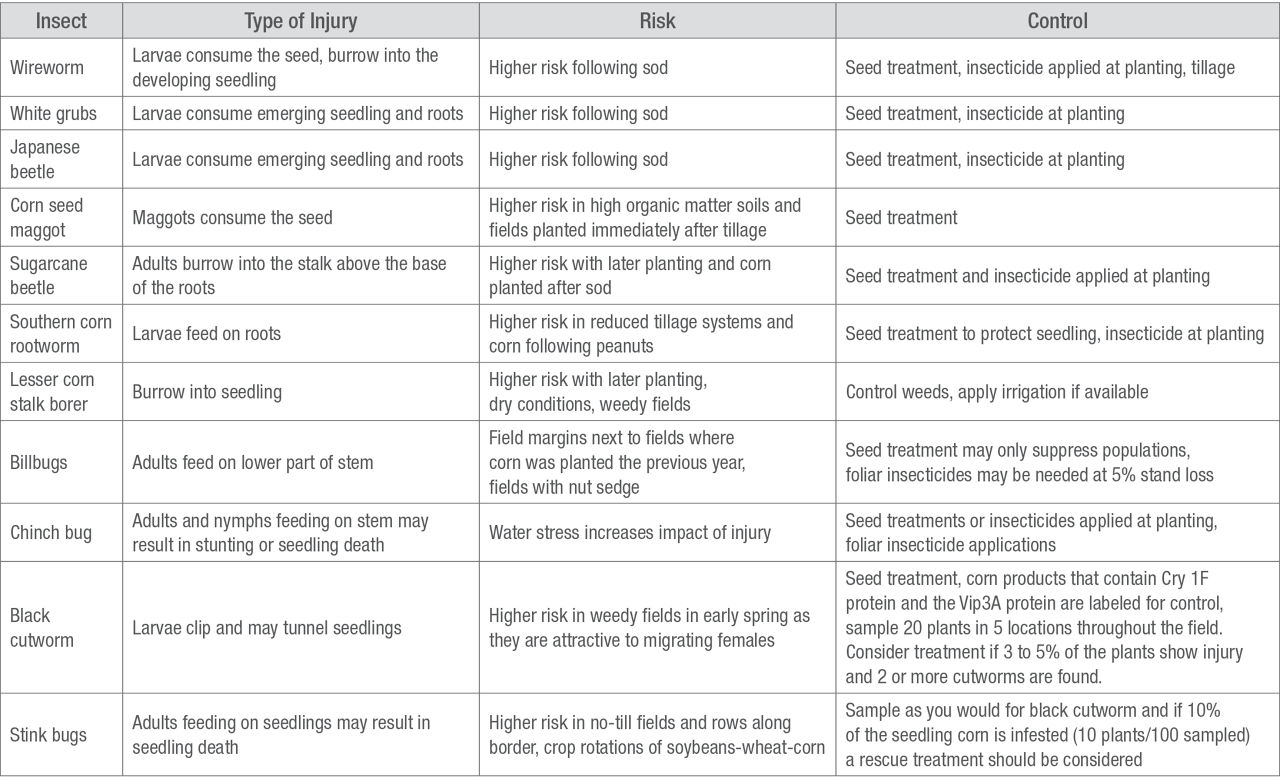7 MIN READ
Do I Need to Apply an Insecticide to Manage Early-season Corn Insects?
December 11, 2023
Some insects that injure corn seed or seedlings can be difficult to manage due to the absence of developed sampling programs and/or rescue treatments to respond to economic damage. And often is the case with these pests, plant injury is the only clue of the presence of the pest. Acceleron® Seed Applied Solutions offers an advanced portfolio of products for corn that protect against early-season insects that feed directly on the seed or seedling, such as seed corn maggot, seed corn beetle, and southern corn rootworm. Including insecticide protection is particularly beneficial to control these insects as they do not currently have sampling programs or rescue treatments available.
What insect pests can attack corn seed in my area?
While it is difficult to predict which, if any, early-season insect pests may cause economic injury, there are some situations where the risk of injury is increased. For example, fields coming out of sod or grass-alfalfa mixtures have a higher risk of injury by white grubs, billbugs, sugarcane borer, Japanese beetle grubs, and wireworm. Fields high in organic matter (manure applied or cover cropped) and tilled close to planting have a higher risk of injury by seed corn maggot and seed corn beetle. Black cutworm moths can migrate from southern Texas and Mexico on winds associated with storms. Females seek fields with winter annual weeds to deposit eggs; therefore, fields with these weeds would be at higher risk.
While field history is not always a predictor of future insect injury, if a field or specific area on the farm has a history of economic injury by a particular pest, it should be considered in the decision-making process as risk is assessed.
Can planting timing influence the type of insect pest and the pest levels?
Yes. Planting timing can impact the insect species as well as the population density. For example, early planting may decrease the risk of injury by black cutworm, billbugs, and chinch bugs but increase the risk of injury by seed corn beetles and wireworms from delayed seedling emergence at a time when temperatures are cooler.
What other factors can contribute to higher risk of early-season injury?
Soil type and weather conditions can impact insect injury risk. Sandy or course-textured soils are associated with a higher risk of injury by lesser corn stalk borer, particularly under dry conditions and when corn is planted late. Corn produced in reduced tillage systems has a higher risk of injury by stink bug and corn flea beetle, but a lower risk from lesser corn stalk borer, seed corn beetle, and seed corn maggot.
What should I look for when scouting for some of these pests?
Often with seed or seedling insect pests, the first clue is a reduced stand or reduced seedling vigor. Black cutworms hide under clods of dirt or just beneath the soil surface, so gently looking under clods or using a hand rake to “till” the soil can help find larvae. A pocketknife can remove soil near the base of the seedling to look for injury to the stem. On very hot days, stink bugs seek cooler conditions in soil cracks and under debris, making detection difficult.
Is there a rescue treatment that can be used for early-season pests?
For some insect pests that attack the seedling, such as black cutworm, billbugs, and stink bugs, sampling programs and thresholds are available through local extension recommendations. However, there are many early-season pests that currently do not have sampling programs and treatment threshold recommendations. Table 1 provides a summary of the major early-season corn insect pests in the southern states.
Table 1. A summary of major early-season corn insect pests in the South.1, 2, 3

Sources:
1 Reay-Jones, F.P. 2023. Corn insect control. 2023. South Carolina Pest Management Handbook for Field Crops. Clemson University Cooperative Extension Service. https://www.clemson.edu/extension/.
2 Brown, S. 2023. Corn insect guide. The University of Tennessee Institute of Agriculture. https://guide.utcrops.com/corn/corn-insect-guide/.
3 Reisig, D. 2014. Stink bugs in corn. North Carolina State University Extension. https://entomology.ces.ncsu.edu/2014/07/stink-bugs-in-corn/.
1215_66496